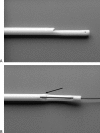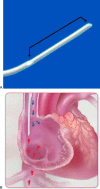A review of evolving dialysis catheter technologies
- PMID: 21326500
- PMCID: PMC3036434
- DOI: 10.1055/s-0029-1222453
A review of evolving dialysis catheter technologies
Abstract
Dialysis catheters continue to play a vital role in the delivery of hemodialysis to patients for both temporary vascular access, serving as a bridge to permanent access, and for long-term access for patients with end-stage renal disease (ESRD). During the past decade, there has been an emergence of technological advancements in the design of dialysis catheters in an attempt to reduce catheter malfunction, decrease infection rates, and improve their long-term efficiency. New improvements in catheter design are aimed at translating into improved catheter performance. This review article summarizes some of the novel catheter designs developed within the last decade.
Keywords: Dialysis; catheters; end-stage renal disease; tunneled catheters.
Figures




References
-
- Anonymous III. NKF-K/DOQI clinical practice guidelines for vascular access: update 2000. Am J Kidney Dis. 2001;37(1, Suppl 1):S137–S181. - PubMed
-
- Tokars J I, Frank M, Alter M J, Arduino M J. National surveillance of dialysis-associated diseases in the United States, 2000. Semin Dial. 2002;15(3):162–171. - PubMed
-
- U.S. Renal Data System USRDS 2008 Annual Data Report: Atlas of End-Stage Renal Disease in the United States. Bethesda, MD: National Institute of Health, National Institute of Diabetes and Digestive and Kidney Diseases; 2008.
-
- Willms L, Vercaigne L M. Does warfarin safely prevent clotting of hemodialysis catheters? A review of efficacy and safety. Semin Dial. 2008;21(1):71–77. - PubMed
LinkOut - more resources
Full Text Sources
Other Literature Sources
Miscellaneous

